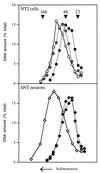Terminally differentiated human neurons repair transcribed genes but display attenuated global DNA repair and modulation of repair gene expression
- PMID: 10669734
- PMCID: PMC85340
- DOI: 10.1128/MCB.20.5.1562-1570.2000
Terminally differentiated human neurons repair transcribed genes but display attenuated global DNA repair and modulation of repair gene expression
Abstract
Repair of UV-induced DNA lesions in terminally differentiated human hNT neurons was compared to that in their repair-proficient precursor NT2 cells. Global genome repair of (6-4)pyrimidine-pyrimidone photoproducts was significantly slower in hNT neurons than in the precursor cells, and repair of cyclobutane pyrimidine dimers (CPDs) was not detected in the hNT neurons. This deficiency in global genome repair did not appear to be due to denser chromatin structure in hNT neurons. By contrast, CPDs were removed efficiently from both strands of transcribed genes in hNT neurons, with the nontranscribed strand being repaired unexpectedly well. Correlated with these changes in repair during neuronal differentiation were modifications in the expression of several repair genes, in particular an up-regulation of the two structure-specific nucleases XPG and XPF/ERCC1. These results have implications for neuronal dysfunction and aging.
Figures







References
-
- Bates S, Vousden K H. p53 in signalling checkpoint arrest or apoptosis. Curr Opin Genet Dev. 1996;6:12–19. - PubMed
-
- Bill C A, Grochan B M, Meyn R E, Bohr V A, Tofilon P J. Loss of intragenomic DNA repair heterogeneity with cellular differentiation. J Biol Chem. 1991;266:21821–21826. - PubMed
-
- Cooper P K, Nouspikel T, Clarkson S G, Leadon S A. Defective transcription-coupled repair of oxidative base damage in Cockayne syndrome patients from xeroderma pigmentosum group G. Science. 1997;275:990–993. - PubMed
-
- Enoch E, Norbury C. Cellular responses to DNA damage: cell-cycle checkpoints, apoptosis and the roles of p53 and ATM. Trends Biol Sci. 1995;20:426–430. - PubMed
-
- Ford J, Hanawalt P C. Expression of wild-type p53 is required for efficient global genomic nucleotide excision repair in UV-irradiated human fibroblasts. J Biol Chem. 1997;272:28073–28080. - PubMed
Publication types
MeSH terms
Grants and funding
LinkOut - more resources
Full Text Sources
Other Literature Sources
